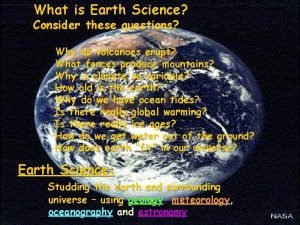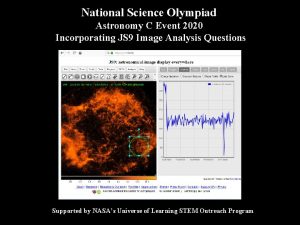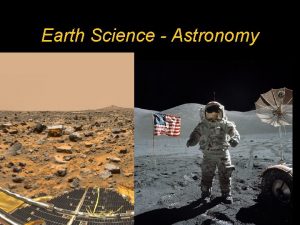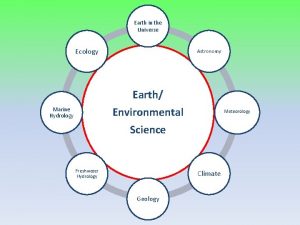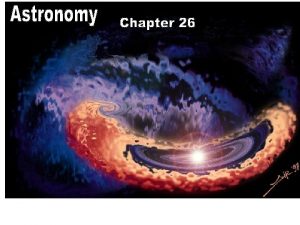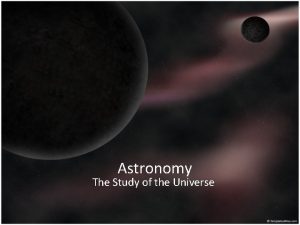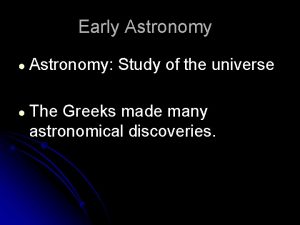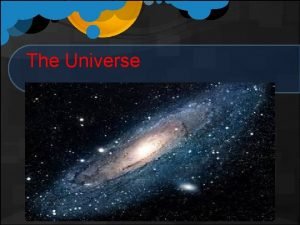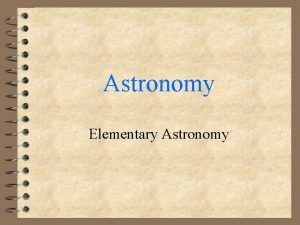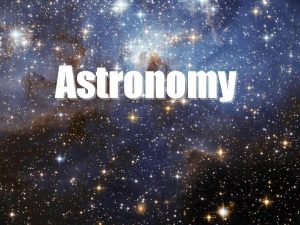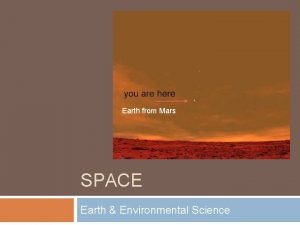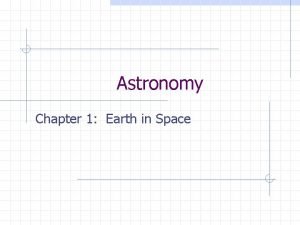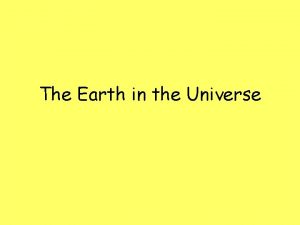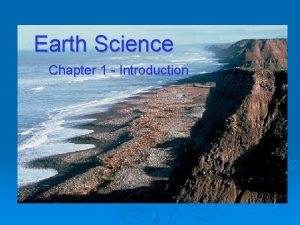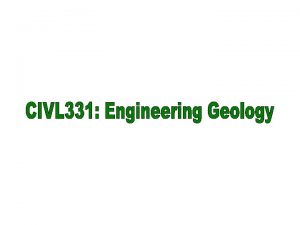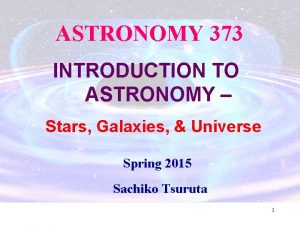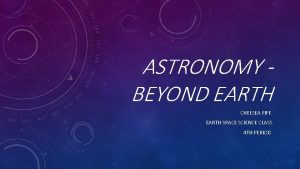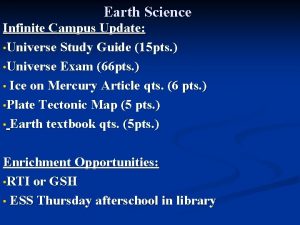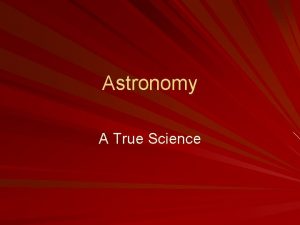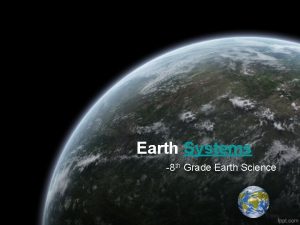Astronomy Earth Science Astronomy Study of the Universe





































- Slides: 37

Astronomy Earth Science

Astronomy – Study of the Universe l MAJOR PLAYERS (Greeks) l l Aristotle – The Earth is round l Eratosthenes – Size of the Earth l Angle of sunlight differed by 7 degrees between Aswan and Alexandria l 7 degrees = 1/50 of a circle l C = 39, 400 km (actual = 40, 075 km) l Hipparchus – Catalogued 850 stars

Astronomy l Models of the Universe l Geocentric l Geo (Early Greeks) – earth centric – center – Earth centered l Moon, Sun, Mercury, Venus, and Jupiter orbit Earth l All other stars remained in the same position l Known as the celestial sphere

Astronomy l Models l Heliocentric (Aristarchus) l Helio—sun centric—center Sun centered l Earth and other planets orbit the Sun l Aristarchus used geometry to calculate the distance to the Sun and moon l Earth centered theory dominated Western thought for nearly 2, 000 years.

Isaac Newton English physicist l Developed the Laws of Motion l 1 st Law of Motion l l An object in motion stays in motion unless acted upon by an outside force. An object at rest stays at rest unless acted upon by an outside force.

l 2 nd Law of Motion l The acceleration of an object is in the same direction as the net force on the object l F = ma l 3 rd Law of Motion l For every action there is an equal and opposite reaction

Johannes Kepler l Kepler developed the Laws of Planetary Motion 1. 2. 3. The orbit of every planet is an ellipse. A line joining a planet and the sun sweeps out equal areas during equal intervals of time as the planet travels along its orbit. Longer orbits have longer periods, and the speed of a planet in a larger orbit is lower than in a smaller orbit. l l D 3 = T 2 D= distance in AU T= period in years 1 Astronomical Unit = 93 million miles! l Distance from the Earth to Sun

Practice Problem l Calculate the period of Mercury if it is 0. 39 AU away from the Sun. D=0. 39 AU T=? D 3=T 2 0. 393 = T 2 T = 0. 24 years

Practice Problem l Calculate the distance Mercury is from the Sun if its period is 0. 24 years. D=? T=0. 24 years D 3=T 2 D 3 = 0. 242 T = 0. 39 AU

Formation of the Universe l It is believed that the Universe started 13. 7 billion years ago as a massive explosion l The entire Universe was confined to a dense, hot, supermassive ball But how do we know this? l All galaxies appear to be moving away from the Earth l Data indicates the universe is still expanding l Cosmic background radiation l

Formation of a Galaxy l l Astronomers have come up with multiple theories as to the formation of galaxies One theory suggests that after the Big Bang millions of gas clouds (nebulae) and star clusters merged together Note: Deep Field Image was taken in a spot of sky near the Big Dipper about the width of a dime 75 ft away.

We are here


Center of Galaxy l Milky Way galaxy is 100, 000 light years across and 3, 000 light years thick l Light travels 10, 000, 000 kilometers in one year l

Star Formation Stars are born in dark, cool interstellar clouds called a nebula. l These clouds begin to contract and gravity begins to pull every particle to the center l A protostar is in the beginning stages of formation and lasts around 1 million years l Once the internal temperature reaches 10 million Kelvin, nuclear fusion begins l

Star Formation l Main Sequence l. A hot blue star will deplete their hydrogen fuel in a few million years l A yellow star (our Sun) may last for 10 billion years l Red Giants l The star expands, the outer atmosphere expands and the core shrinks

Star Formation l White Dwarfs l Once the star has depleted all of its fuel it collapses under its own gravity l AKA a supernova l Sometimes a star will release its outer layer of gas creating a planetary nebula

Star Formation l Supernovas and Neutron Stars l. A neutron star is a small, massive star that remains after a supernova l A supernova occurs when the outer layer of the star is ejected and the star collapses

Hertzsprung-Russell Diagram A star’s brightness as it appears from Earth is the apparent magnitude. l Three factors: l l How big it is l How hot it is l How far away it is l The absolute magnitude is how bright the star actually is l Two stars of the same absolute magnitude usually do not have the same apparent magnitude because one may be much farther from us than the other

Hertzsprung-Russell Diagram Astronomers determine what magnitude the stars would have if they were at a standard distance of 32. 6 light-years. l A light year is the distance light travels in one year l l The Sun: apparent magnitude of __-26. 7__, absolute magnitude of __5. 0_. l The more negative, the brighter; the more positive, the dimmer.


Solar System Formation l Current theory suggests the solar system was formed from a rotating disk of dust and gases l Called the Nebular Theory A nebula is a collection of gas and dust l Most matter in the nebula collected at the center l


Solar System Formation l The first bodies of the solar system were planetesimals l Eventually built up enough mass to exert a gravitational pull l Animation: (View on your own) l http: //www. nrao. edu/index. php/Star%20&%20 Plan et%20 Formation

Terrestrial Planets The inner planets are small and rocky l Mercury l l Absorbs 94% of the sunlight l Many craters l Venus l Thick clouds help reflect sunlight l Surface temp. = 475 degrees Celsius l Atmosphere is 97% Carbon dioxide

Terrestrial Planets l Mars l Surface is mostly Iron oxide (rust) l Atmosphere is mostly carbon dioxide l Some evidence of water

Jovian Planets The outer planets are large…many times the diameter of earth l Composed of a variety of gases l Most have a rocky core l All have ring systems l Jupiter, Saturn, Uranus, Neptune l

Galileo 1. Discovered four moons orbiting Jupiter

Galileo 2. 3. Planets are circular disks and not just points of light Venus has phases just like the moon

Galileo 4. The moon’s surface is not smooth

Galileo 5. The Sun has sunspots (areas of the sun with “cooler” temperatures)

Asteroid Belts Two belts l Belt between Mars and Jupiter (failed planet) l Kuiper Belt (International Astronomical Union) l l Region of the Solar System beyond Neptune l Pluto resides in this belt l Irregular orbit l Many thousands of objects



Refracting Telescopes Galileo’s first telescope (30 x) l Uses lenses to bend or refract light l

Reflecting Telescope Newton built the first reflecting telescope l Use a concave mirror that focuses light in front of the mirror l

Radio Telescopes Detect radio waves from distant objects l Can use during the daytime or inclement weather l Detect collisions of galaxies, black holes, binary stars, etc… l
 Astronomy definition earth science
Astronomy definition earth science Learning astronomy by doing astronomy activity 1 answers
Learning astronomy by doing astronomy activity 1 answers Learning astronomy by doing astronomy activity 7 answers
Learning astronomy by doing astronomy activity 7 answers Learning astronomy by doing astronomy activity 1 answers
Learning astronomy by doing astronomy activity 1 answers Why study earth science
Why study earth science My favorite subjects
My favorite subjects Astronomy science fair projects
Astronomy science fair projects Astronomy science olympiad
Astronomy science olympiad Hình ảnh bộ gõ cơ thể búng tay
Hình ảnh bộ gõ cơ thể búng tay Slidetodoc
Slidetodoc Bổ thể
Bổ thể Tỉ lệ cơ thể trẻ em
Tỉ lệ cơ thể trẻ em Gấu đi như thế nào
Gấu đi như thế nào Tư thế worms-breton
Tư thế worms-breton Hát lên người ơi
Hát lên người ơi Các môn thể thao bắt đầu bằng từ đua
Các môn thể thao bắt đầu bằng từ đua Thế nào là hệ số cao nhất
Thế nào là hệ số cao nhất Các châu lục và đại dương trên thế giới
Các châu lục và đại dương trên thế giới Công thức tính thế năng
Công thức tính thế năng Trời xanh đây là của chúng ta thể thơ
Trời xanh đây là của chúng ta thể thơ Cách giải mật thư tọa độ
Cách giải mật thư tọa độ Phép trừ bù
Phép trừ bù Phản ứng thế ankan
Phản ứng thế ankan Các châu lục và đại dương trên thế giới
Các châu lục và đại dương trên thế giới Thơ thất ngôn tứ tuyệt đường luật
Thơ thất ngôn tứ tuyệt đường luật Quá trình desamine hóa có thể tạo ra
Quá trình desamine hóa có thể tạo ra Một số thể thơ truyền thống
Một số thể thơ truyền thống Bàn tay mà dây bẩn
Bàn tay mà dây bẩn Vẽ hình chiếu vuông góc của vật thể sau
Vẽ hình chiếu vuông góc của vật thể sau Biện pháp chống mỏi cơ
Biện pháp chống mỏi cơ đặc điểm cơ thể của người tối cổ
đặc điểm cơ thể của người tối cổ Thế nào là giọng cùng tên?
Thế nào là giọng cùng tên? Vẽ hình chiếu đứng bằng cạnh của vật thể
Vẽ hình chiếu đứng bằng cạnh của vật thể Phối cảnh
Phối cảnh Thẻ vin
Thẻ vin đại từ thay thế
đại từ thay thế điện thế nghỉ
điện thế nghỉ Tư thế ngồi viết
Tư thế ngồi viết




